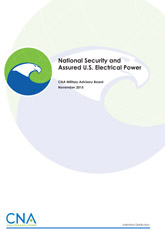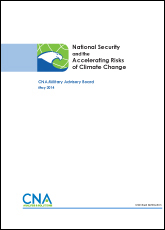CNA's Military Advisory Board Reports

The CNA Military Advisory Board (MAB) is an elite group of retired three- and four-star flag and general officers from the Army, Navy, Air Force, and Marine Corps that studies pressing issues of the day to assess their impact on America’s national security.
The Role of Water Stress in Instability and Conflict
Watch the U.S. report launch event on Feb. 6, 2018 at the Wilson Center
As senior military officers, we see water stress—the lack of adequate fresh water—as a growing factor in the world’s hot spots and conflict areas, many of vital interest to the United States. Our earlier reports have identified a nexus among climate, water, energy, and U.S. national security. We have previously shown how emerging resource scarcity across this nexus can be a threat multiplier and an accelerant of instability. With escalating global population and the impact of a changing climate, we see the challenges of water stress rising with time. It is in this context that we now seek to provide a better understanding of the mechanisms through which water factors into violence and conflict.
This report examines the role of water across a spectrum from civil unrest and localized violence to terrorism, insurgencies, and civil wars to state-on-state conflict. Focusing on water-stressed areas of the world, it articulates the role water plays not only in diplomacy, violence, and conflict, but also how water can be used as a tool of coercion across the spectrum of conflict. Additionally, the research provides insight into how water stress can empower violent extremist organizations and place stable governments at risk.
Findings
- Decreased water availability can be the principle cause of civil unrest and localized violence.
- Water can bring nation states to the negotiating table to engage in diplomatic talks across a broad range of issues, with water access being both a key bargaining chip as well as a principal objective.
- Actual or perceived changes to current or future shared water resources can add to tensions between upstream and downstream states, but this has been and remains unlikely as a singular cause for state-on-state war.
- Water stress can be exploited by non-state actors, violent extremist organizations (VEOs), insurgents, and other belligerents.
- Water stress can trigger destabilizing secondary effects, which can lead to conflict.
- There will be more and widespread occasions of civil unrest and localized violence, with a greater sense of urgency to change perceived governmental inadequacies.
- As the availability of water decreases, it will become a more valuable tool in the operational strategy for belligerents as well as a larger bargaining chip in diplomatic negotiations.
- Lower availability of or less access to fresh water will likely add to tensions among neighbors sharing river basins, and finding mutually acceptable diplomatic solutions will become more challenging.
Recommendations
- Security elements of the United States government should regard global water stress as a growing national security concern.
- In areas of strategic interest to the U.S. and our allies, expand diplomatic efforts, investment, and technical leadership in the mitigation of water stress.
- Expand diplomatic efforts to prevent and mitigate conflicts among countries that share water resources. This will become increasingly important as water stress worsens.
- Increase U.S. engagement in the development and deployment of water management practices, technologies, and innovations.
- Incentivize private-sector engagement to spur innovation and improve water management practices. Solutions won’t come from government alone.
- Develop a common foresight tool to identify areas of emerging water stress, with a focus on the potential for unrest.
- Develop stronger communications nodes and strategies for alerting the interagency and the international community to the potential for conflict or violence in water-stressed areas.
- Integrate water stress into strategic-level documents and guidance, such as the National Military Strategy and National Defense Strategy, Geographic Combatant Command theater campaign plans, conflict assessments, risk vulnerability, regional planning, and other material.
- Incorporate regional water stress information and impact into the U.S. strategy to counter violent extremism.
- Designate an office within the Office of the Secretary of Defense to be responsible for global water stress and to coordinate across the interagency on water-stress issues.
Advanced Energy and U.S. National Security
It is undeniable that the global energy landscape is changing. Burgeoning populations in South Asia and Africa, together with rising affluence, are shifting major centers of demand away from Europe and the U.S. and increasing the world’s overall demand for energy. At the same time, new technologies are making clean, affordable advanced energy widely available as well as allowing the extraction of fossil fuels from previously inaccessible sources. We see this combination of rising energy demand and the growing number of affordable energy choices as a tectonic shift in the global energy posture, one likely to impact every nation. As new energy options emerge to meet global demand, nations that lead stand to gain; should the U.S. sit on the sidelines, it does so at considerable risk to our national security.
In this report, we provide the Administration, Congress, and other Federal and State policymakers our assessment, observations, and recommendations concerning the national security impacts of a transition to advanced energy systems. President Trump’s commitment to “promote clean and safe development of our Nation’s vast energy resources,” his acknowledgment that “the prudent development of these natural resources is essential to ensuring the Nation’s geopolitical security,” and his recognition that it is “in the national interest to ensure that the Nation’s electricity is affordable, reliable, safe, secure, and clean, and that it can be produced from coal, natural gas, nuclear material, flowing water, and other domestic sources, including renewable sources” provides opportunity for today’s emerging advanced energy technologies to play a critical role in meeting these goals.
Findings
- A changing global energy landscape will have economic, diplomatic, and military effects, impacting the national security of the U.S. and its allies.
- A historic global transition toward advanced energy is accelerating and will give rise to economic challenges–and opportunities–for the U.S., our allies, and our adversaries.
- Electric vehicles will drive significant reduction in oil demand for the U.S. and other nations where petroleum is mostly used in light-duty transit.
- Advanced energy systems will temper rising global demand for oil, impacting global diplomacy and influence, with direct national security implications for the U.S.
- The transition to advanced energy can provide the U.S. military with additional options to improve mission effectiveness, reliability, and cost mitigation.
- The military’s philosophy on advanced energy is simple: Use them when they improve the effectiveness or resiliency of military operations.
- Growing demand for reliable electric power will drive the need for more resilient, more efficient, and more distributed electric power generation systems. Today, a critical hindrance to intermittent energy sources fulfilling this need is energy storage.
- Strong leadership and investment in advanced energy can provide great opportunity for the U.S. to maintain competitive advantage.
- The wide portfolio of advanced energy technologies provides options for U.S. energy independence through clean and safe development of our vast energy resources, while enhancing our geopolitical security.
Recommendations
- The U.S. government should develop a comprehensive national energy strategy that promotes energy independence and U.S. engagement and leadership in the advanced energy future.
- The national security challenges and opportunities of the evolving global energy landscape, including advanced energy transition, should be fully integrated into national security and national defense strategies.
- The U.S. should identify and leverage global opportunities that will arise during the transition to advanced energy, especially in fast-growing India and Africa.
- The Department of Defense should identify, embrace, and deploy advanced energy technologies where they improve the effectiveness of military operations.
- The U.S. should take a leadership role in the transition to advanced energy.
National Security and Assured U.S. Electrical Power (2015)
The trends are clear. The current way Americans produce and distribute electricity is at increasing risk. At the same time, the way we produce and use energy is radically changing. Just as the twentieth century was dominated by energy derived from oil and coal, the twenty-first century will see much greater energy diversity including solar, wind, small nuclear reactors, hydrogen, and other low-carbon sources. Assuring that we have reliable, accessible, sustainable, and affordable electric power is a national security imperative. Our increased reliance on electric power in every sector of our lives, including communications, commerce, transportation, health, and emergency services, in addition to homeland and national defense, means that large-scale disruptions of electrical power will have immediate costs to our economy and can place our security at risk. Whether it is the ability of first responders to answer the call to emergencies here in the U.S. or the readiness and capability of our military service members to effectively operate at home or deployed in theater, these missions are directly linked to assured domestic electric power.
The current U.S. electric grid's overreliance on aging twentieth-century technology, based on large, centralized power generation and interconnected distribution architecture, makes it susceptible to a wide variety of threats, including: severe weather and other natural disasters; direct physical attack, or cyberattack; and accidents associated with the age of the grid or human error. The national security vulnerabilities associated with the grid leave the U.S. open to both small/short-duration and large/long-duration power outages.
Findings
- We validated the findings in our 2009 report, Powering America's Defense: Energy and the Risks to National Security, which linked the vulnerability of the domestic electricity grid to weather, accidents, and attacks. In the six years since the release of the report, the risks associated with attacks—such as those by transnational terrorist groups (e.g., ISIS) and "lone-wolf" perpetrators, as well as cyberattacks—have increased dramatically.
- With the grid of the future, electricity will be produced closer to consumers, from a wide variety of sources, and stored or shared until needed. The new production paradigm will be driven by technological advances, demand for increased flexibility, more secure and lower-cost power, and a growing public demand for cleaner energy sources.
- Existing technologies like micro-grids, proven distributed electrical generation systems including wind, solar, and geothermal, and evolving systems using distributed electrical generation plants like commercial scale hydrogen engines, fuel cells, small modular reactors, and emerging energy storage systems can increase electrical generation and distribution security. These—and other—technologies, coupled with energy efficiency can provide the U.S. with a more reliable and secure power supply.
- In the long term, smart design and effective planning can ensure that critical research and development investments in advanced electric generation, storage, and emerging technologies can be incorporated smoothly into the grid without barriers or obstacles. A new, flexible, open architecture grid paradigm will provide for electrical energy that is generated closer to the user and will be less of a strategic target. We must act NOW.
Recommendations
- Develop a formal national strategy for strengthening the security and resilience of the electric grid through a "whole-of government" approach at all levels—from the Nation's Capital, down to local governments.
- Examine and act to change misaligned government incentives and policy-based deterrents.
- Incorporate an advanced energy economy strategy into all grid modernization, repair, and rebuilding efforts.
- Conduct quantitative risk analysis, including assigning monetary values for impacts associated with the complete set of threats to the grid.
- Seize the opportunity to build the new grid, smarter, better, and cleaner.
- Promote data collection, analysis, and transparency.
- Invest in the grid at a level commensurate with its strategic significance to our everyday lives.
National Security and the Accelerating Risks of Climate Change (2014)
As a follow-up to its landmark 2007 study on climate and national security, the CNA Military Advisory Board's National Security and the Accelerating Risks of Climate Change re-examines the impact of climate change on U.S. national security in the context of a more informed, but more complex and integrated world.
The Board's 2007 report described projected climate change as a "threat multiplier." In this report the 16 retired Generals and Admirals who make up the board look at new vulnerabilities and tensions posed by climate change, which, when set against the backdrop of increasingly decentralized power structures around the world, they now identify as a "catalyst for conflict."
In the seven years since the first Military Advisory Board (MAB) report, developments in scientific climate projections, observed climate changes (particularly in the Arctic), the toll of extreme weather events both at home and abroad, and changes in the global security environment have all served to accelerate the national security implications of climate change. While there has been some movement in efforts to plan effective responses to these challenges, the lack of comprehensive action by both the United States and the international community to address the full spectrum of projected climate change issues remains a concern.
The specific questions addressed in this update are:
- Have new threats or opportunities associated with projected climate change or its effects emerged since our last report? What will be the impacts on our military?
- The 2014 National Climate Assessment indicates that climate change, once considered an issue for a distant future, has moved firmly into the present. What additional responses should the national security community take to reduce the risks posed to our nation and to the elements of our National Power (Political, Military, Social, Infrastructure, and Information systems (PMESII))?
Ensuring America's Freedom of Movement: A National Security Imperative to Reduce U.S. Oil Dependence (2011)
In 2006, CNA brought together 11 recently retired three and four-star generals and admirals to form a Military Advisory Board (MAB), with the goal of examining the national security implications of climate change. Over the last five years, the MAB has published three reports on the nexus of energy, climate, and national security. In this report, the MAB focuses on the national security implications associated with shifting the U.S. transportation sector to alternative fuels.
Discussions of energy are discussions of national security. One directly affects the other. The MAB's previous reports have made clear the deep connections between energy, the economy, climate change, and security. In this report, the MAB narrows in on one aspect of U.S. energy posture—our heavy reliance on oil, especially imported oil—and calls for immediate and aggressive actions to move our transportation sector away from oil and toward alternative, domestically produced sources of energy in order to improve our national security posture.
Findings
- America's dependence on oil constitutes a significant national security threat.
- A 30 percent reduction in our use of petroleum would significantly improve our national security.
- We can achieve a significant portion of a 30 percent reduction through greater efficiency in how we use oil.
- There are many promising alternatives to oil as a transport fuel—some available today, others on the horizon. If managed properly, all of the most promising alternative fuels examined can lower overall national security risks rather than continuing our overreliance on oil as a singular fuel source.
Recommendations
- To assure our national security, government must take action to promote the use of a more diverse mix of transportation fuels and to drive wider public acceptance of these alternatives.
- In the immediate future, our nation's leaders must develop a comprehensive energy roadmap or strategic plan to enable consistent and strategic energy policies and investments.
- The U.S. must take swift and aggressive action to reduce our use of oil.
- The Department of Defense should continue to be a leader in advancing alternative transportation fuels while balancing mission effectiveness and overall efficiency. DOD must be provided the necessary resources so innovation and experimentation with alternative fuels is not traded for military capability and capacity. DOD should be provided with the necessary authority to establish long-term alternative fuel contracts as a way to assure markets and lower the alternative fuel price.
Powering America’s Economy: Energy Innovation at the Crossroads of National Security Challenges (2010)
Powering America’s Economy: Energy Innovation at the Crossroads of National Security Challenges explores the growing challenges presented by the links that tie the nation’s current energy posture to its economy and national security. It looks at the potential opportunities that could result from the transition to a clean energy technology-based economy and the key role that the Department of Defense (DOD) can play to support innovation and commercialization of clean, low-carbon energy, thereby directly contributing to America’s future economic competitiveness and bolstering national security. Key questions addressed in this report:
- What are the key links between national security, energy, and the economy?
- What are the national security challenges and benefits of developing a clean energy economy in the United States?
- How can DOD contribute to America’s economic and national security while addressing its own energy challenges?
Powering America’s Defense: Energy and the Risks to National Security (2009)
Powering America’s Defense: Energy and the Risks to National Security is a report by CNA's Military Advisory Board (MAB) that explores the impact of America's energy choices on our national security policies. This report follows the MAB's groundbreaking 2007 report National Security and the Threat of Climate Change, which found that "climate change, national security, and energy dependence are a related set of global challenges."
This new volume builds on that finding by considering: the security risks inherent in our current energy posture; energy choices the nation can make to enhance our national security; the impact of climate change on our energy choices and our national security; and the role the Department of Defense can play in the nation’s approach to energy security and climate change.
Throughout 2008, CNA's Military Advisory Board assessed America's energy posture and the potential threats it posed to our national security.
The Board and its study team received briefings from energy experts, representatives of the U.S. intelligence community, scientists, engineers, policymakers, senior military officers, business leaders, legislators and their staff, regulators, and non-profit leaders. They met extensively with representatives of the Department of Defense and the Department of Energy, and visited the National Renewable Energy Laboratory in Golden, Colorado to meet with senior scientists and engineers and receive briefings on the latest energy technologies.
Board members also presented their own views, based on experience, of the impact energy choices have on our national security and on battlespace effectiveness, and on the technical, fiscal and policy challenges that shape these choices.
The result of this year-long effort yielded Powering America’s Defense: Energy and the Risks to National Security drafted to better inform U.S. policymakers and the public about the impact of America's energy choices on our national security policies. The issues explored were considered solely for their impact on America's national security as viewed through the lens of the extensive military experience of the Military Advisory Board
National Security and the Threat of Climate Change (2007)
In 2006 CNA convened a Military Advisory Board (MAB) of eleven retired three-star and four-star admirals and generals to assess the impact of global climate change on key matters of national security, and to lay the groundwork for mounting responses to the threats found.
In April 2007, CNA released the MAB's landmark report, National Security and the Threat of Climate Change, that articulates the concept of climate change acting as a "threat multiplier" for instability in some of the most volatile regions of the world and identifies key challenges that must be planned for now if they are to be met effectively in the future.
Findings
- Projected climate change poses a serious threat to America's national security.
- Climate change acts as a threat multiplier for instability in some of the most volatile regions of the world.
- Projected climate change will add to tensions even in stable regions of the world.
- Climate change, national security and energy dependence are a related set of global challenges.
Recommendations
- The national security consequences of climate change should be fully integrated into national security and national defense strategies.
- The U.S. should commit to a stronger national and international role to help stabilize climate changes at levels that will avoid significant disruption to global security and stability.
- The U.S. should commit to global partnerships that help less developed nations build the capacity and resiliency to better manage climate impacts.
- The Department of Defense should enhance its operational capability by accelerating the adoption of improved business processes and innovative technologies that result in improved U.S. combat power through energy efficiency.
- DoD should conduct an assessment of the impact on U.S. military installations worldwide of rising sea levels, extreme weather events, and other possible climate change impacts over the next 30 to 40 years.




